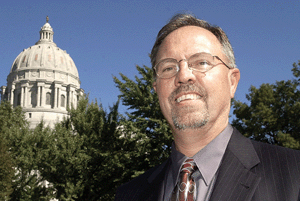States push collaboration with feds

Stay the course.
Stay the course.That's why Gerry Wethington ran for a second term as president of the National Association of State Chief Information Officers. Wethington, Missouri's CIO, wanted to bring stability to the Lexington, Ky.-based organization, which saw a large turnover in its ranks because of the 2002 gubernatorial elections.Re-elected last month, Wethington hopes to continue the momentum the association gained in shifting from an organization that just holds conferences to one that provides products and services to its members and the governments they serve.Before he was appointed state CIO by Missouri Gov. Bob Holden in October 2000, Wethington was director of the information systems division for the Missouri State Highway Patrol. His experience in criminal justice and public safety has served him well, as state CIOs now are keenly focused on cybersecurity and critical infrastructure protection. Wethington recently spoke with Staff Writer William Welsh about the issues facing the states' CIOs. What are the association's top initiatives? In the IT strategy arena, we have some very strong interests. One is to develop business cases around using IT for better government. It is important for us to go into individual states and take topics that are of importance ? whether that is business continuity, enterprise architecture, project management ? and build a business case using the examples in the business case primer that we put together; so we are actually starting to use our own products. Another area we want to focus on is procurement reform. We will try to come up with some guidelines that we can bounce off of the model procurement document practices that states follow. How can the private sector help state governments?One [way] is how we structure and manage our infrastructure. Look at all the silo infrastructure that sits throughout the states. In Delaware and Virginia, governors have asked for a more cohesive and comprehensive technology infrastructure. [These states] say we have to look at where are we overinvested, and how we [can] centralize and standardize to be more efficient. The public-private partnership has to be one in which the partners are willing to share that risk and delay their receipt of benefits until they begin to accrue at the state level as well. Another area would be helping us understand how to streamline business processes and identify which ones really do need to exist in multiple areas and which ones need to be standardized. What progress has been made in getting more flexibility in how federal IT funds are spent? We're still pushing that effort, [and we have had the opportunity to raise the topic repeatedly with the House Government Reform Committee]. It is interested in that topic. We need to continue to put together that message, so that we begin to break down the silos of funding. What homeland security initiatives will the association push next year? Two big issues are building out our IT infrastructure, and then making sure cybersecurity is recognized as being as significant as it really is. There's probably a lack of recognition about how critical cybersecurity is [to state government]. I don't believe we've made the progress that we would like to see there, and you probably don't have to look any further than the announcement made just in the last few weeks that IT funding in the homeland security area is down. I don't think this is a time when you want to be decreasing your IT spending, because it is where you can bring efficiencies into government. So it is frustrating to see both that and funding for e-gov initiatives decline. What are the key issues NASCIO wants to bring to the federal government's attention? You will see us continue to talk about security and privacy. There are going to be huge issues on how federal and state government can collaborate, particularly in cybersecurity and identity theft.We will continue to talk about advanced planning document reform [to shorten approval time for federal grants]. It's not just acceptable to talk about re-engineering business processes at the federal level, where you're talking about an internal federal department, but not re-engineer the business processes to provide efficiencies between federal and state government. They have to start, at the federal level, using some of their own theories, so they are going to have to talk about reuse and business process re-engineering, particularly as it applies to that state relationship. So [advanced planning document] reform is going to be one of the big efforts. One thing we will push is getting recognition at the federal level that not all solutions are generated [at that level], but that the states have a lot of good solutions that we all need to be willing to reuse. It can't be a trickle-down effect; it has to be a [two-way] exchange of solutions. Massachusetts recently became the first state to adopt a strategy of moving all its computers to open standards. What is the significance of that? A lot of states are probably doing the same thing. They just aren't talking as openly about it, but are doing it as part of infrastructure evaluation and analysis. More and more you can see people settling on two or three solutions that are tied into Web services, which [use] open architecture and open standards. You're seeing people move in that direction. I believe Massachusetts is stepping out front and talking openly about its strategy. You will find that same strategy in other states, but it just isn't the kind of thing you can cut a ribbon on. Why did you run for a second term as NASCIO president? We've had a tremendous amount of turnover in last 30 months. Since Dec. 9, 2002, we have had 26 new CIOs. That is a fairly significant number. We need some continuity in leadership. Typically, the vice president moves into the presidential role, but in this case [Delaware CIO] Tom Jarrett had only been vice president for about four or five months. I still had the energy to do it and the interest in doing it. Staff Writer William Welsh can be reached at wwelsh@postnewsweektech.com.

WT:
Wethington:
WT:
Wethington:
WT:
Wethington:
WT:
Wethington:
WT:
Wethington:
WT:
Wethington:
WT:
Wethington:

Gerry Wethington, Missouri's CIO, re-elected president of the National Association of State Chief Information Officers last month, wants to keep the organization's momentum going on cybersecurity and critical infrastructure protection.
Steven Brooks
WT:
Wethington:
WT:
Wethington:
WT:
Wethington:
WT:
Wethington:
WT:
Wethington:
WT:
Wethington:
WT:
Wethington:
NEXT STORY: Mass. Medicaid contract